|
Cover
Story
Surfing Through theWaves of Fashion
There are few things that can survive the onslaught of time. In the world of fashion especially, nothing is static and few brands can claim supremacy for years on end. Yet, in spite of the ruthless competition between fashion houses, a few manage to survive the transitory nature of this arena, purely on the basis of their goodwill, brand loyalty of the customers and the constant effort to innovate and keep afloat with changing tastes and trends.
One brand that can be directly associated with the history of men's fashion in Bangladesh is Cat's Eye, a fashion house that is celebrating its 25th anniversary this May. Starting out as a small shop in Green Supermarket in the 1980s Cat's Eye has managed to survive and thrive well into the 1990s and the present times. With 27 outlets in Dhaka and other major cities, Cat's Eye continues to provide its clientele with clothes that are comfortable as well as in vogue.
AASHA MEHREEN AMIN
and
AHMEDE HUSSAIN
Photo: Zahedul I Khan
 In Bangladesh, while men's fashion has in no way reached the level of importance as in other Asian countries (even neighbouring ones), the growing exposure to cable television and rapid urbanisation, has ensured a good market for trendy men's wear. Teenagers and young men in their twenties especially, are becoming increasingly fashion-conscious. The need to ape their favourite pop artiste or Bollywood actor or just to look 'cool' prompts many of these men to invest more on the clothes they wear. Young executives of banks, multinationals and corporations provide the market for stylish, yet more conservative corporate wear. Thus the influx of foreign brands in the clothing stores, most of which are very highly priced. This leaves a free field to local designers and manufacturers to provide trendy clothes for middle and upper middle-class clients that don't cost an arm and a leg. In Bangladesh, while men's fashion has in no way reached the level of importance as in other Asian countries (even neighbouring ones), the growing exposure to cable television and rapid urbanisation, has ensured a good market for trendy men's wear. Teenagers and young men in their twenties especially, are becoming increasingly fashion-conscious. The need to ape their favourite pop artiste or Bollywood actor or just to look 'cool' prompts many of these men to invest more on the clothes they wear. Young executives of banks, multinationals and corporations provide the market for stylish, yet more conservative corporate wear. Thus the influx of foreign brands in the clothing stores, most of which are very highly priced. This leaves a free field to local designers and manufacturers to provide trendy clothes for middle and upper middle-class clients that don't cost an arm and a leg.
The biography of Cat's Eye, a company that was considered the guru of fashion in the 1970s and 1980s, gives an idea of the labour of love behind this successful enterprise. The story could not get more romantic. A 17-year-old girl and 20-year-old boy fall in love, tie the knot and then leave their homeland to seek their fortune abroad. When Rumi and Dora arrived in Canada in 1973, all they wanted to do was start a life together in a land of endless opportunities. Even when both of them got jobs that brought them in close proximity with the fashion business, they were quite oblivious of their calling.
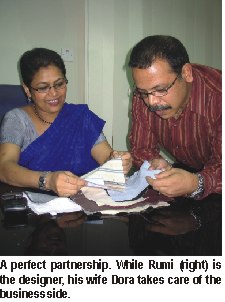 "It was by coincidence that I started working for Le Chateau, a company that epitomised fashion for the young," says Rumi (Sayeed Siddiqui) who admits that he always had a weakness for good clothes. Meanwhile, his wife Dora (Ashrafun Siddiqui) was also working in an upscale fashion company, getting a feel about the know-hows of the fashion business, knowledge that would prove invaluable in later years. "It was by coincidence that I started working for Le Chateau, a company that epitomised fashion for the young," says Rumi (Sayeed Siddiqui) who admits that he always had a weakness for good clothes. Meanwhile, his wife Dora (Ashrafun Siddiqui) was also working in an upscale fashion company, getting a feel about the know-hows of the fashion business, knowledge that would prove invaluable in later years.
"Rumi used to take various courses related to fashion such as in marketing, trends and merchandising, and we always used to talk about our dream to do something in our own country," says Dora who now takes care of the managerial and operations side of their business.
"From day one we were sure that we would come back and do something," says Rumi. According to plan, the couple with their first child who was born in Canada, came back and opened a little shop in Green Supermarket. Perhaps Rumi was living out his childhood dream of being a 'dokandar' (shopkeeper) when he started this shop that sold assorted items -- from milk and candy to ornaments. But there was also a corner displaying shirts designed by Rumi and Dora. Rumi would draw the designs and give it to his aunt, an expert stitcher, or his sisters and they would stitch the clothes. The couple was quite taken aback by the enthusiastic response from a Dhaka where there were few stores for men, least of all those selling anything stylish.
The designs offered by Cat's Eye were completely new and avante-garde for Dhaka's youth, thirsty for anything that was novel and contemporary. They were also Bangladesh- made, which appealed to the patriotic spirit of young people of the time. "People would wait for our collections," recalls Rumi, " and they would buy everything." The store's unorthodox name also drew much attention. Named after the semi precious stone -- a favourite of Rumi's -- the brand gives a hint at the unconventional, almost eccentric side of its creators, and represents a sense of fun and excitement that is so alluring to young people.
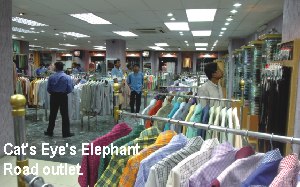 A year-and-a-half later, confident about the possibilities and determined to make them happen, Dora convinced her husband that it was time to take the business to a more serious level. The duo went to Islampur Clothes Market and bought material worth Tk 20,000. With the help of an expert cutting master called Ibrahim, Rumi learnt the most important thing about making a shirt -- how the material should be cut. "The secret to our lastability," says Rumi, is that I learnt how to cut. Why a shirt is $200 or $20 is not just the fabric but in the cutting. When you can anticipate the next trend and cut accordingly, it will be successful." A year-and-a-half later, confident about the possibilities and determined to make them happen, Dora convinced her husband that it was time to take the business to a more serious level. The duo went to Islampur Clothes Market and bought material worth Tk 20,000. With the help of an expert cutting master called Ibrahim, Rumi learnt the most important thing about making a shirt -- how the material should be cut. "The secret to our lastability," says Rumi, is that I learnt how to cut. Why a shirt is $200 or $20 is not just the fabric but in the cutting. When you can anticipate the next trend and cut accordingly, it will be successful."
After a quarter of a century, it is still the cutting that gives Cat's Eye a competitive edge over other local brands, although a lot has changed in terms of how the shirts are made and how the business is run. Research, for instance, is a lot more detailed now. The couple often go abroad and one thing they make sure of doing is to go to stores selling top brands to get a feel of current trends. A significant range of shirts are contoured in line with foreign brands, and are made to fit perfectly with the shape of the body. Others are slightly loose as many customers prefer loosefits. Rumi is very fussy about details such as buttons, the shape of the collar or the inside stitches of a shirt. The attention to detail, says Rumi, is what makes Cat's Eye shirts different from the run-of-the mill shirts found in other stores. "Whatever the trend we anticipate it and manufacture it accordingly," says Rumi, adding, "We never give sales as we don't have stock piles which means our anticipation is correct." He is so fanatic about getting the best designs that even when he goes to Singapore to get checkups for a back injury that once had left him paralysed, all he can think of is when he will visit the clothes stores.
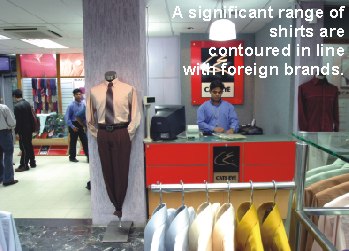 The fabric too is no longer bought from Islampur but purchased by the couple themselves from Thailand and patterns are bought from top French designer brands. The fabric too is no longer bought from Islampur but purchased by the couple themselves from Thailand and patterns are bought from top French designer brands.
While the company caters to mainly young men who go for what is funky and 'in' using the Cat's Eye and Cat's Eye Unlimited logos, its sister concern, Monsoon Rain, is contoured to meet the needs of corporate attire. It includes formal, semi-formal clothes and accessories for office-going men who want to look both sophisticated and in fashion. Obviously this calls for a different kind of designing than what the usual Cat's Eye clothes demand. "The colours are more subdued and the fitting less contoured," explains Rumi.
The main office is located in Elephant Road, a prime shopping spot for middle-class consumers; other branches are scattered all over the city including Banani and Bashundhara City in Panthapath. But operations are run from the Elephant Road office which occupies nine floors thanks to a genial landlord. Sophisticated computer software allows the management to look after all the outlets including those in Chittagong and Sylhet. The factory is also situated in the main office and shirts are manufactured using state of the art machinery.
 Though foreign brands like Zodiac and St Michael are intruding into the Bangladeshi market, Rumi is not afraid of competition. He believes, to ward off foreign invasion, local houses need to come up with new ideas and innovative designs. Pricing is another factor, the seasoned designer believes, that goes in favour of local designers. "As long as the supply of labour is plenty and the cost of production remains low we should not be afraid of the big names," he says. "We can produce international quality shirts at Tk 700 while any Louis Philippe will cost you more than Tk 2,000," he explains. Though foreign brands like Zodiac and St Michael are intruding into the Bangladeshi market, Rumi is not afraid of competition. He believes, to ward off foreign invasion, local houses need to come up with new ideas and innovative designs. Pricing is another factor, the seasoned designer believes, that goes in favour of local designers. "As long as the supply of labour is plenty and the cost of production remains low we should not be afraid of the big names," he says. "We can produce international quality shirts at Tk 700 while any Louis Philippe will cost you more than Tk 2,000," he explains.
On top of it all, Cat's Eye has a bunch of loyal customers whose tastes Rumi has moulded over the years. "We have got a very loyal clientele, who have showed an unflinching loyalty towards us," he says.
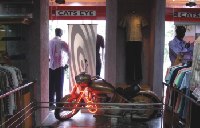 Dora confirms this. "We have clients, who were young, when we started operations years ago, have grown up to become office executives," she says. "But throughout this period," Dora continues, "our clients have never abandoned us though loads of so-called high-flying local and foreign designers have floated different brands in the market." Dora confirms this. "We have clients, who were young, when we started operations years ago, have grown up to become office executives," she says. "But throughout this period," Dora continues, "our clients have never abandoned us though loads of so-called high-flying local and foreign designers have floated different brands in the market."
It is a tough job indeed to keep an army of clients happy over such a long period of time, when men's fashion has gone through a major overhaul. "One of the reasons," Rumi confides, "is that we have evolved with the changing world of fashion." To his surprise, Rumi still comes across clients who used to buy clothes during the Green Supermarket days and now wants the designer to update them about the latest trends.
 The number of units sold has crossed the 35,000 benchmark last year and the company is even getting queries from abroad. "I never gave it serious thought," Rumi says, "but lately I am getting inquiries from New York and Malaysia." Though they have not decided about it, trade expansion is certainly on the cards. "Business increases by its own need," Dora says. The number of units sold has crossed the 35,000 benchmark last year and the company is even getting queries from abroad. "I never gave it serious thought," Rumi says, "but lately I am getting inquiries from New York and Malaysia." Though they have not decided about it, trade expansion is certainly on the cards. "Business increases by its own need," Dora says.
But the government's uncooperative trade regime, as always, has remained the biggest blob of frustration in this otherwise picture-perfect success story. "I would love to have a gunny-sack sewing machine to stitch hip collars that has become the latest trend in the west," he says. But, as Cat's Eye caters solely to the local market, the government's trade law slaps a 100 percent tax on any machinery that it wants to import. "It's only because we don't have an export license, we have to pay an exorbitant amount to the exchequer whereas different garment companies pay only the Value Added Tax (VAT)," Rumi says. He believes if the government changes its policy towards local designer houses, the country's economy will be benefited in the long run.
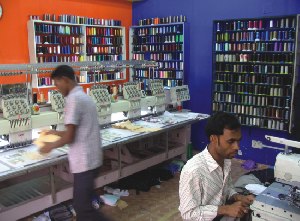 Apart from the sophisticated sewing and stitching machines, Cat's Eye's much needed fabrics also come from abroad. "We have suppliers in Thailand who buy fabrics for us," Rumi says. As the local fabric industry has not developed yet, the company has to wait a few more years before it can say it makes a 100 percent Bangladeshi product. Apart from the sophisticated sewing and stitching machines, Cat's Eye's much needed fabrics also come from abroad. "We have suppliers in Thailand who buy fabrics for us," Rumi says. As the local fabric industry has not developed yet, the company has to wait a few more years before it can say it makes a 100 percent Bangladeshi product.
For Dora and Rumi there are more reasons to celebrate the 25th year of their dream. Over the years, Cat's Eye has become a family-run business with Rumi's younger brother, Riyad Siddiqui (Rousseau), the couple's elder daughter Raffaella Siddiqui in the management team with their younger daughter Rummaela Siddiqui about to join. The enterprising couple continues to nurture their company with dedication and sincerity but are also very practical about the future. "We don't plan what will happen with our lives," says Rumi. "We want to take pride in our work and take things step by step," adds Dora. Perhaps the greatest satisfaction for the couple is that Cat's Eye has caught the attention of more than one generation and has become a household name in Bangladesh's fashion scene. Copyright
(R) thedailystar.net 2005 |
| |
